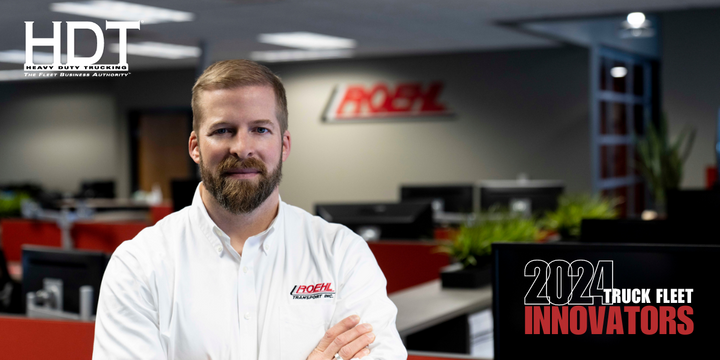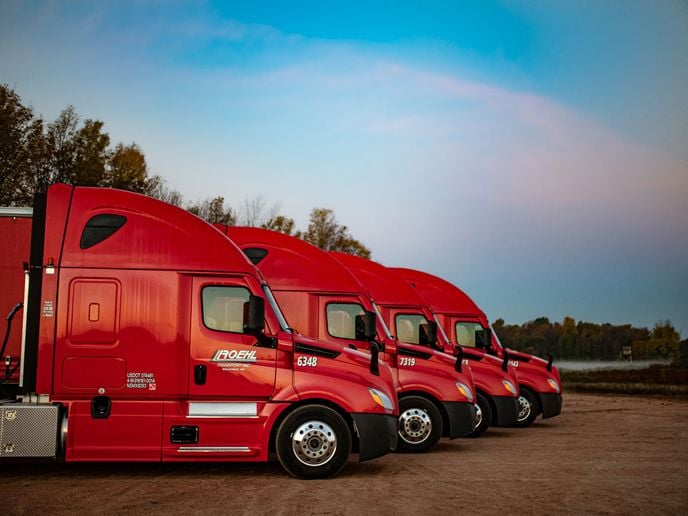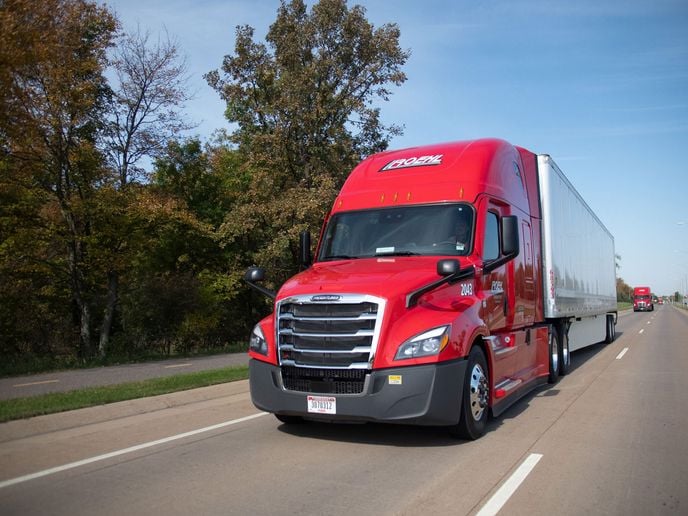Trucker Access › Forums › Diesel News › Custom Software Helps Roehl Stay Ahead – Fleet Management
- This topic has 0 replies, 1 voice, and was last updated 9 months, 2 weeks ago by
 EazyRiDer66.
EazyRiDer66.
-
AuthorPosts
-
June 20, 2024 at 2:45 pm #26501
 EazyRiDer66Keymaster
EazyRiDer66Keymaster

John Paape is VP of Information Technology at Roehl Transport.
Image: HDT Graphic | Roehl Transport Photos
John Paape has overseen the digital transformation of Roehl Transport. Yet he had never worked in transportation logistics before he met CEO Rick Roehl, having a background in technology in other industries such as medical and manufacturing.
“When I met Rick and the executive team, I really liked what they were saying about the role that technology played at their organization,” he says. “And for me, obviously, that’s really important. And so I decided to join Roehl.”
Marshfield, Wisconsin-based Roehl operates some 2,200 trucks and 5,800 trailers, offering dry van, flatbed, refrigerated, dedicated, and curtainside transportation.
When he worked in manufacturing, Paape says, the companies he worked for seemed to view technology as a necessary evil.
In contrast, at Roehl, he says, there’s a culture of embracing technology.
“There’s such a pull from our business users for more and more and more, because I think they see how it adds value to what they do.”
Roehl’s Custom Software Provides Better Ability to Pivot
Roehl is unusual among its peers and even larger competitors, Paape says, in that it has an in-house custom software shop.
“So many of our competitors run off of a commercial off-the-shelf package as a TMS and kind of build from there. But there’s definitely limitations, whether it’s cost limitations or time limitations.”
He turns to his Navy background for a metaphor, comparing a company using off-the-shelf software packages to an aircraft carrier.
“It doesn’t turn very quick, right? I feel like Roehl is more like a battleship. We can pivot so quickly. Because we control all of our code, whether it’s our TMS, our EDI, or our brand new maintenance system end to end to go fully digital on the bays.
“There’s been so much stuff that we’ve done, to really just control our destiny. When we see an opportunity, we just can pivot so quickly to that.”
The Pros and Cons of Roehl Transport’s Custom Software Approach
One benefit of having its own custom software, Paape says, is that Roehl doesn’t have the oft-cited frustration of other fleets in trying to get all the different software systems to communicate with each other.
“Everything is a unified data source. When we talk truck number, or a unit number or VIN number, it’s the same across to all of our systems. It’s already going off of one centralized database. So in terms of data sharing, it’s extremely powerful. Because we’re not having to integrate all these disparate systems, it is literally one seamless system from end to end, that does a lot of stuff.”

“When we talk truck number, or a unit number or VIN number, it’s the same across to all of our systems. It’s already going off of one centralized database,” Paape says.
That’s not to say there aren’t challenges in the custom approach, Paape acknowledges.
“It’s not been something we built overnight. I’ve been here for 10 years. Some of the foundational pieces were here when I joined. Since then, we’ve greatly expanded. But it’s taken us a long time to get where we are.”
Another challenge is maintaining all that code.
“As we get more and more systems and lines of code out there that we own, we’re also responsible for maintaining those, for making sure they’re secure,” he explains, something that commercial software providers help other fleets stay on top of.
“As our technology stack grows, so does our technical debt in terms of things that we have to manage and maintain,” Paape says. “I think we’ve done a pretty good job balancing the maintenance aspects of our code with the innovation parts of what we need to do for the business.”
Sometimes they end up leaving some parts of the older code bases alone longer than they’d like, because the IT team is working to take advantage of a unique opportunity.
“So we don’t spend as much time as we’d love to ideally,” he says. “We could spend every day going back and just making it better and better and better.
“But every new tool that we write, we are always implementing the newest tools within that. And then we try and go retrofit our older code into those solution sets.
“So I guess that has always kind of kept us relevant. It’s kept us learning continually.”
Cybersecurity a Growing Challenge in Trucking
So how many IT people does it take to keep up with writing and maintaining software for a 2,200-truck fleet? There are 45 people in Roehl’s IT department.
“A big chunk of our headcount growth over the past couple of years has been in our security space, like every organization, putting the right resources against those risks,” Paape says.
That’s another reason that it’s important to go back into that older code and address any security vulnerabilities.
In fact, he says, at Roehl’s quarterly IT summit it hosts to keep everyone up to date on technology and industry trends, one of its large customers shared how they went through a ransomware situation that impacted their organization for a couple of weeks.
“It’s very real, and it’s all around us. And we spend a lot of time every day combating that.”
Working with EDI and API and Old-Fashioned Communication Methods
One recent project that’s “boring but important” was redoing Roehl’s whole EDI infrastructure, building it out in the cloud.
“Really refreshing our whole environments, so our systems can operate at the speed of business that it’s operating at today,” he says.
“EDI is not super exciting; you’re not going to get people to say, ‘Oh, my gosh, I can’t wait to read about that,’” Paape acknowledges. “But 94% to 95% of our revenue comes in through that conduit.
“So the lifeblood of most large carriers is that EDI, and API to some extent. API is going to be the thing of the future. But right now, EDI is your heartbeat.”
While the industry has been talking for years about better alternatives to EDI, Paape doesn’t see it going away soon.
“There’s some technologies that just don’t want to go away,” he says. “I’m guessing most flatbed carriers will tell you that they’re even getting a good portion through fax yet for some reason.
“EDI is entrenched in our space. I’m sure even when I retire there’s going to be plenty of EDI transactions.”
Creating a Maintenance Technology Platform at Roehl
Roehl’s maintenance platform was its last remaining system still based on the IBM AS400 computer — revolutionary when first introduced in the late 1980s but viewed by many as outdated today.
“A lot of our competitors track downtime in days. We track it in minutes,” Paape says. “We really focus on getting our drivers in and out as quickly as possible.

“A lot of our competitors track downtime in days. We track it in minutes,” Paape says. But it needed to create a software system that could help the maintenance department operate at that pace.
“And how we did that, our maintenance team and the culture in our maintenance team is fantastic. We just built a tool that really fits in exactly how they feel we should run our maintenance department, versus trying to fit our processes into a preexisting tool.”
Under the new system, technicians all use tablets that provide all the information they need — no going back and forth from the truck to a computer in the bay.
It’s tied in to the driver inspection reports done at the fuel islands and safety islands when drivers come in. While those inspections have been done digitally for years, the difference is in how it flows into what the technicians see.
“Their ability to see what work this specific truck has to have done and anything that they picked up on an inspection and be able to schedule it right there before they even leave the fuel Island.”
Not only does it make things more efficient for the shop, it’s also a key in driver satisfaction because it leads to a minimal amount of downtime and disruption to their day.
Conquering the Flood of Fleet Safety Data
Like other fleets, Roehl faced the challenge of actually having too much safety data for it to be used effectively.
“We had cameras in trucks, we had phone numbers in the back of our trailers, we had data streaming in from our OEM manufacturer in terms of braking events and lane deviation events, and we had all this stuff. And the challenge was that everything came into its own portal and our fleet managers had to log in there to see what was relevant.
“And at the end of the day, even though fleet managers had really good intentions, they couldn’t effectively manage across all these different portals,” Paape says.
“Nor did our leadership know how good those coaching discussions were happening with drivers — and if they were actually creating the needed change in a certain behavior.”
So Roehl set out to build a single pane of glass solution, which integrated with all these different data sources and brought them all into one interface.
Now, when events come in, they are automatically classified into two dozen different unique events, from predictive analytics to camera events and OEM sensor readings.
From there, Paape gives an example of how a hard-braking event is handled.
“That’s something that needs to be coached in 24 hours or less. So as soon as that event gets in, it gets assigned to the appropriate fleet manager. And then there’s a timer that’s set to make sure fleet managers are dealing with their coaching opportunities within the desired timeframe or better.”
For any camera events, at the push of a button, the fleet manager can share that video to the driver’s phone, so they can see the video themselves.
“That’s worth a thousand words right there,” Paape says. “If they can actually see themselves doing something, that automatically changes the conversation from convincing them it happened to, ‘Okay, yeah, I need to do that better next time.’”
The actual coaching call is saved and stored within the coaching system, so supervisors can audit those calls and see if the coaches need coaching, so to speak.
But how do you know if the coaching worked? If the actual problematic behavior changed?
The coaching tool includes a fleet manager effectiveness scoring system that looks at repeat occurrences of that behavior by that same driver within a certain timeframe.
“If it gets past that timeframe, we can say, that was a successful coaching event. If it happened again, that would show up in the effectiveness score, as well.”
Paape says while the Roehl team know this was unique, when they demonstrated it to their insurer as part of their safety presentation, “They were kind of blown away by the whole aggregation and end to end management of all these events. They actually came back a second time and brought some more people just to see the system because they had not seen anything like it before.”
Artificial Intelligence Offers Exciting Opportunities
One project Roehl is currently working on involves implementing artificial intelligence into one of its safety systems. He couldn’t yet share details.
We’ve used predictive analytics for a long time. And we have our own data science area here at Roehl. But this is a little bit different than data science, although there’s a lot of overlap there. But we are really excited about productionalizing a specific model this year to help further improve some of our safety results. So it’s pretty exciting.”
Paape notes that while he sees many opportunities in trucking for expanding the use of AI, the industry is still early stages as far as adopting the new LLM/generative AI technology.
“So I think it’s a crawl, walk, run,” he says. “We’ve tried to focus in on one small piece in our safety area. And if that works, like we expect it to, I think there’s really huge opportunities for us to expand that.”
-
AuthorPosts
- You must be logged in to reply to this topic.